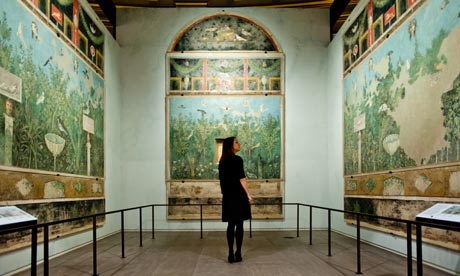Life and Death in
Pompeii and Herculaneum at the British Museum and the Lichtenstein
Retrospective at Tate Modern were slated to be the two biggest blockbuster
exhibitions for London’s museums in 2013. If you travel on the Tube then you
couldn’t fail to have noticed the absolutely enormous marketing campaign that
has driven Pompeii to sell out week after week for it’s timed entry slots. Also
if you are like me, you might have been slightly baffled by a poster featuring
an old-timey looking picture of a volcano. You might have even, just for a
second, thought ‘wow, amazing that they have a picture of that eruption’,
before feeling like an idiot and glancing around furtively to see if anyone was
reading your mind at just that moment.
To be fair to the British Museum, they have tried to do
something a bit different. Rather than just focusing on the gruesome plaster
casts of Vesuvius’s victims, the exhibition focuses instead on the everyday
life of Romans in this area that the eruption accidently preserved. I can
honestly say I did learn some new things. I’ll cut them down to three to make
it simple.
1) Never
ever start an exhibition with a 10-15 minute long introductory video. 10
minutes?! In what way does a step-by-step scientific explanation of how
volcanoes work contribute to your ‘life and death’ theme? Does this really need
to be coupled with contemporary images of Italians making dinner? I felt like I
was watching a bad into to Italian language film. And that theme of linking it
to present day didn’t really follow on in the exhibition anyway, so why bother?
Stop it exhibition planners, no one wants to watch intro videos longer than 4
minutes.
2) Whoever
organized the logistics for this exhibition must be some kind of registry/collections
management/ object transport god. Did you see that carbonized table that looked
barely strong enough to support its own weight, let alone travel by plane? How
do you get 6-foot tall Roman frescos hung up on a wall? How much insurance did
the Government Indemnity Scheme foot for this? It’s worth going to see just to
marvel at the sheer cultural power the British Museum wields to get these
things from Italy to London. Seriously impressive.
 |
| Now how do we get these down again... |
3) Romans
are f**king hilarious and raunchy. Seriously. You can try to teach me all about how the
Romans were early feminists (a theme pushed none too subtly throughout) but no
one is going to remember anything else except the rapey goat statue and the
inappropriate tavern fresco. The hilarious cartoon-ish decorations from a
tavern feature a narrative of a couple getting frisky, two lads getting in a
bar fight over a game of dice, and subsequently getting chucked out by the
owner. ‘It was a three you cock-sucker, I won!’, one of them shouts in Latin.
Bet you wished you learned things like that in school. And then of course,
there’s this.
When we entered this area of the
exhibition, the friend I was with (naming no names) actually shrieked with joy.
‘I can’t believe it’s here! It’s one of my ten sexiest objects in museums!’
Apparently this anonymous museum professional (for her own protection) actually
has a list of incredibly explicit objects in museums around the world that she
wants to visit. Well, congratulations, this one certainly is spectacular. The
label tried to argue that this Roman garden statue is in fact misunderstood. A
satyr his himself half-goat, so it’s not really that strange, and besides,
maybe the female goat likes it? Not so sure about that. I think it’s just that
zany Roman sense of humour we all know and love.
All in all, you should still
probably go to this exhibition if you get the chance. Nothing earth shattering
here, but there are certainly some stunning objects to be seen and interesting
Roman-based trivia to be learned. I’ll leave you with just this shocking
revelation. Did you know Roman houses had GLASS WINDOW-PANES?! Watch out for
that on your next pub quiz.
Life and Death in Pompeii and Herculaneum is on until September 29th. Book tickets well in advance!



No comments:
Post a Comment